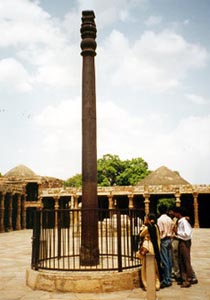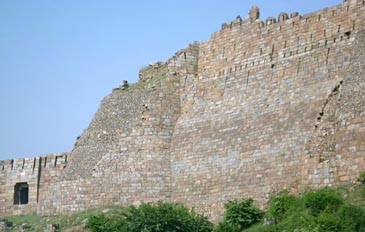Delhi History
 Delhi has seen the rise and fall of many empires which have left behind a plethora of monuments that attest to the grandeur and glory of bygone ages. Traditionally, Delhi is said to be the site of the magnificent and opulent Indraprastha, capital of the Pandavas in the Indian epic Mahabharata. A village called Indarpat existed in Delhi until the beginning of the 19th century. The ancient historic village was obliterated to make place for construction of New Delhi by the British.
Delhi has seen the rise and fall of many empires which have left behind a plethora of monuments that attest to the grandeur and glory of bygone ages. Traditionally, Delhi is said to be the site of the magnificent and opulent Indraprastha, capital of the Pandavas in the Indian epic Mahabharata. A village called Indarpat existed in Delhi until the beginning of the 19th century. The ancient historic village was obliterated to make place for construction of New Delhi by the British.
Excavations have unearthed sherds of the grey painted ware (ca. 1000 BC) that some archaeologists associate with the age of the Mahabharata, but no coherent settlement traces have been found. Some locate Indraprastha in the Purana-Qila area.
The earliest architectural relics age back to the Mauryan Period (ca 300 BCE); since then, the site has seen continuous settlement. In 1966, an inscription of the Mauryan King Ashoka (273-236 BCE) was discovered near Srinivaspuri. Two sandstone pillars inscribed with the edicts of Ashoka were later brought to the city by Firuz Shah Tughluq. The famous Iron Pillar near the Qutub Minar was commissioned by the emperor Kumara Gupta I of the Gupta dynasty (320-540) and transplanted to Delhi at some time in the 10th century. Eight major cities have been situated in the Delhi area. The first four cities were in the southern part of present-day Delhi.
The more recent city is believed to be made up of seven successive cities, the remains of some of which can still be seen on the ground. They are
- Qila Rai Pithora built by Prithvi Raj Chauhan, near the oldest Rajput settlement in Lal-Kot;
- Siri, built by Alauddin Khilji in 1303;
- Tughluqabad, built by Ghiyazudin Tughluq (1321-1325);
- Jahanpanah, built by Muhammad bin Tughluq (1325-1351);
- Kotla Firoz Shah, built by Firuz Shah Tughluq (1351-1388);
- Purana Qila built by Sher Shah Suri and Dinpanah built by Humayun, both in the same area near the speculated site of the legendary Indraprastha (1538-1545); and
- Shahjahanabad, built by Shah Jahan from 1638 to 1649, containing the Lal Qila and the Chandni Chowk.
 The Tomara Rajput dynasty founded Lal Kot, which lies near the Qutub Minar, in 736. In the Prithvirajaraso, the Rajput Anangpal is named as the founder of Delhi. The Chauhan Rajput kings of Ajmer conquered Lal Kot from the Tomaras in 1180 and renamed it Qila Rai Pithora. The Chauhan king Prithviraj III was defeated in 1192 by the Afghan army of Muhammad Ghori. After 1206, Delhi became the capital of the Delhi Sultanate.
The Tomara Rajput dynasty founded Lal Kot, which lies near the Qutub Minar, in 736. In the Prithvirajaraso, the Rajput Anangpal is named as the founder of Delhi. The Chauhan Rajput kings of Ajmer conquered Lal Kot from the Tomaras in 1180 and renamed it Qila Rai Pithora. The Chauhan king Prithviraj III was defeated in 1192 by the Afghan army of Muhammad Ghori. After 1206, Delhi became the capital of the Delhi Sultanate.
The first rulers were known as the Slave Dynasty as many of the rulers of this dynasty were former slaves. This includes the first Sultan of Delhi, Qutb-ud-din Aibak who was a former slave who rose through the ranks to become a general followed by governor and then Sultan of Delhi. Qutb-ud-din started the construction the Qutub Minar, instantly recognisable as a symbol of Delhi, to commemorate his victory but died before its completion. He also constructed the Quwwat-ul-Islam (might of Islam), which is the earliest extant mosque in India, in the Qutb complex.
He was said to have pillaged exquisitely carved pillars from 27 temples for this mosque many of which can still be seen. After the end of the Slave dynasty, a succession of Turkic and Central Asian dynasties, the Khilji dynasty, the Tughluq dynasty, the Sayyid dynasty and the Lodhi dynasty held power in the late medieval period and built a sequence of forts and townships that are part of the fabled seven Delhis. In 1526, following the First Battle of Panipat emperor Babur defeated the last Lodhi sultan and founded the Mughal dynasty which ruled from Delhi, Agra and Lahore.
In the mid-sixteenth century there was an interruption in the Mughal rule of India as Sher Shah Suri defeated Babur's son Humayun and forced him to flee to Afghanistan and Persia. Sher Shah Suri built the sixth city as well as the old fort known as Purana Qila. After his early death, Humayun was able to recover the empire with Persian help as Suri's son was not as able as his father. The third and the greatest Mughal emperor, Akbar, moved the capital of his empire to Agra resulting in a decline in the fortunes of Delhi.
In the mid-seventeenth century, the Mughal Emperor Shah Jahan (1628-1658) built the city that sometimes bears his name (Shahjahanabad), the seventh city of Delhi that is more commonly known as the old city or old Delhi. This city contains a number of significant architectural features, including the Red Fort (Lal Qila) and the Jama Masjid.
The old city served as the capital of the later Mughal empire from 1638 onwards, when Shah Jahan transferred the capital back from Agra. Aurangzeb (1658-1707) crowned himself as the emperor in Delhi in 1658 at the Shalinar garden ('Aizzabad-Bagh); a second coronation took place in 1659.
Delhi passed to British control in 1857 after the First War of Indian Independence; the last Mughal Emperor, Bahadur Shah Zafar II, was pensioned to Rangoon, and the remaining Mughal Territories were annexed as a province of British India. Delhi ceased to be India's capital with the British preferring their city of Calcutta.
In 1911 the Capital of British India was again moved to Delhi from Calcutta. Parts of the Old City were pulled down to create New Delhi, a monumental new quarter of the city designed by the British architect Edwin Lutyens to house the government buildings. A brief but fascinating account of the Indian contractors behind this construction can be found in Khushwant Singh's autobiography Truth, Love and a Little Malice.